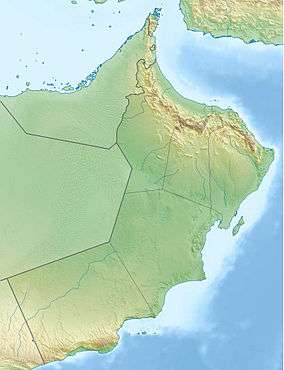Archaeological Sites of Bat, Al-Khutm and Al-Ayn
| Archaeological Sites of Bat, Al-Khutm and Al-Ayn | |
|---|---|
| Name as inscribed on the World Heritage List | |
|
Burial mound at the site of Al-Ayn. | |
| Location |
Al Dhahira region Oman |
| Type | Cultural |
| Criteria | iii, iv |
| Reference | 434 |
| UNESCO region | Arab States |
| Coordinates | 23°16′12″N 56°44′42″E / 23.27000°N 56.74500°ECoordinates: 23°16′12″N 56°44′42″E / 23.27000°N 56.74500°E |
| Inscription history | |
| Inscription | 1988 (12th Session) |
 Location in Oman | |
The Archaeological Sites of Bat, Al-Khutm and Al-Ayn are an important group of necropolis from the 3rd Millennium BC, located near a palm grove. They were declared World Heritage by UNESCO in 1988.
Description
Studies during the last 15 years have shown the existence of numerous human settlements ranging from Persian Gulf to Gulf of Oman.
Bat
The site of Bat is located inside a palm grove. Around 3000 BC there was an intense trade of copper (extracted locally) and stone (probably diorite) with Sumerians.[1] Several Sumerian texts, such as the Epic of Gilgamesh, called it Dilmun. The necropolis consists of 100 graves and circular buildings with a diameter of about 20 meters. These buildings had no openings to the outside, so they might have been tanks or silos, but their purpose is not known for sure. In 1972, the excavations carried out by a Danish team led by Karen Frifelt showed that the city was inhabited continuously for 4000 years.
Al-Khutm
The ruins at Al-Khutm are basically a stone fort, a tower made of rock with a diameter of 20 meters. It is located 2 km west of Bat.
Al-Ayn
Al-Ayn is a small necropolis. Of the three it is the place in better condition. It is located 22 kilometers southeast of Bat.
Conservation
The sites have not been subjected to restoration or other types of conservation before the protection provided by UNESCO, so their isolation has been their only protection. One of the greatest dangers come from that local people who can take building material from the archaeological sites.[1]